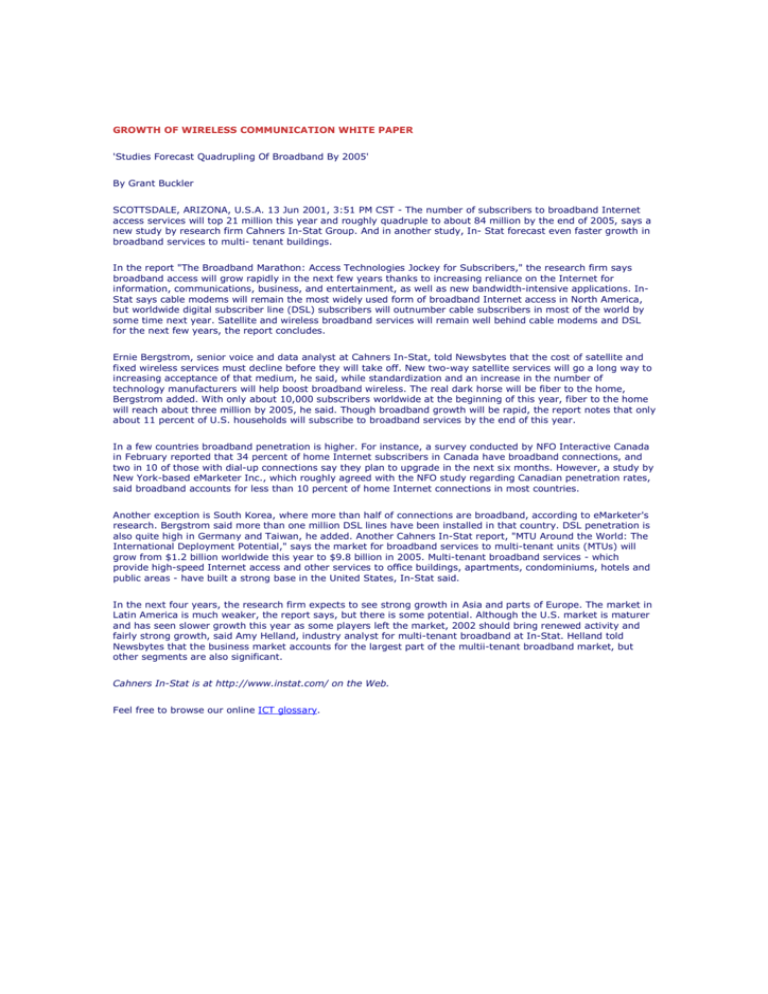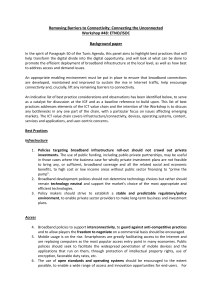GROWTH OF WIRELESS COMMUNICATION WHITE PAPER
advertisement

GROWTH OF WIRELESS COMMUNICATION WHITE PAPER 'Studies Forecast Quadrupling Of Broadband By 2005' By Grant Buckler SCOTTSDALE, ARIZONA, U.S.A. 13 Jun 2001, 3:51 PM CST - The number of subscribers to broadband Internet access services will top 21 million this year and roughly quadruple to about 84 million by the end of 2005, says a new study by research firm Cahners In-Stat Group. And in another study, In- Stat forecast even faster growth in broadband services to multi- tenant buildings. In the report "The Broadband Marathon: Access Technologies Jockey for Subscribers," the research firm says broadband access will grow rapidly in the next few years thanks to increasing reliance on the Internet for information, communications, business, and entertainment, as well as new bandwidth-intensive applications. InStat says cable modems will remain the most widely used form of broadband Internet access in North America, but worldwide digital subscriber line (DSL) subscribers will outnumber cable subscribers in most of the world by some time next year. Satellite and wireless broadband services will remain well behind cable modems and DSL for the next few years, the report concludes. Ernie Bergstrom, senior voice and data analyst at Cahners In-Stat, told Newsbytes that the cost of satellite and fixed wireless services must decline before they will take off. New two-way satellite services will go a long way to increasing acceptance of that medium, he said, while standardization and an increase in the number of technology manufacturers will help boost broadband wireless. The real dark horse will be fiber to the home, Bergstrom added. With only about 10,000 subscribers worldwide at the beginning of this year, fiber to the home will reach about three million by 2005, he said. Though broadband growth will be rapid, the report notes that only about 11 percent of U.S. households will subscribe to broadband services by the end of this year. In a few countries broadband penetration is higher. For instance, a survey conducted by NFO Interactive Canada in February reported that 34 percent of home Internet subscribers in Canada have broadband connections, and two in 10 of those with dial-up connections say they plan to upgrade in the next six months. However, a study by New York-based eMarketer Inc., which roughly agreed with the NFO study regarding Canadian penetration rates, said broadband accounts for less than 10 percent of home Internet connections in most countries. Another exception is South Korea, where more than half of connections are broadband, according to eMarketer's research. Bergstrom said more than one million DSL lines have been installed in that country. DSL penetration is also quite high in Germany and Taiwan, he added. Another Cahners In-Stat report, "MTU Around the World: The International Deployment Potential," says the market for broadband services to multi-tenant units (MTUs) will grow from $1.2 billion worldwide this year to $9.8 billion in 2005. Multi-tenant broadband services - which provide high-speed Internet access and other services to office buildings, apartments, condominiums, hotels and public areas - have built a strong base in the United States, In-Stat said. In the next four years, the research firm expects to see strong growth in Asia and parts of Europe. The market in Latin America is much weaker, the report says, but there is some potential. Although the U.S. market is maturer and has seen slower growth this year as some players left the market, 2002 should bring renewed activity and fairly strong growth, said Amy Helland, industry analyst for multi-tenant broadband at In-Stat. Helland told Newsbytes that the business market accounts for the largest part of the multii-tenant broadband market, but other segments are also significant. Cahners In-Stat is at http://www.instat.com/ on the Web. Feel free to browse our online ICT glossary.








